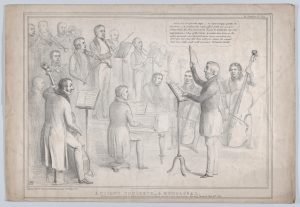The art of Musicking is seen throughout generations, across oceans and countries, throughout the vast variety of cultures that fill our world. It links together humans by allowing us to see similarities between all people groups in the way they do music. As I started researching I was reflecting upon the use of music in cultures and people groups. We have been discussing in class how the colonists and the people in America during the 1700s and 1800s used music.
Upon reflecting on that I was thinking about music as a social construct. In class we had been mostly focusing on the psalmody and different forms of church music of the time. Simply looking at the way slaves used an excited celebration style of music for church while their slaveowners focused more on the liturgical aspect. However, we haven’t yet really delved into the use of social music.
I found a newspaper article from January 3, 1856 written in Brooklyn. The article is title “Social Music” and found in the “Home Paragraphs” portion of the paper. Reading through the article, the unknown author uses a poetic writing to describe the beautiful uses of social music in the mid 1800s. Beginning their article, the author introduces other “studies” of the time that fall short of the enticing aspect of music such as history, arithmetic, and French. None of these can compare to the stunning use of music that brings a people together.
“Community as this, to the pleasure we experience in listening to music discoursed by a great variety of instruments, in the hands of skillful players, and all making beautiful harmony with each other… When this is done–when an individual produces a perfect sound–it brings every other member into sympathy with him. It kindles the elements of love and unity in his own heart and in the hearts of all around him.” –Home Paragraphs

The picture above is just one of the fine ways people used music as a social construct. The artist, John Doyle, portrayed this “Rehearsal” as an opportunity for the beauty that the Home Paragraphs described as “bringing every other member into sympathy with him.
A journal article from February 17, 1855 titled “Music and the Pianoforte” from the Scientific American opens with,
“In all civilized nations has mustc been cultivated as one of the fine arts, and even among savages has it received some attention. Any country may well be judged of its advancement in civilization by the musical progress and education of its people. Inspired by the love of melody, man has made and used various instruments for the production of music, from the eights generation to the present time.” -Music and the Pianoforte
Works Cited:
Artist: John Doyle (Irish, Dublin 1797-1868 London), et al. Ancient Concerts – A Rehearsal / HB Sketches, No. 538. p. 1, https://jstor.org/stable/community.18409726. The Metropolitan Museum of Art;https://www.metmuseum.org/.
C, A. R. “Home Paragraphs.: SOCIAL MUSIC.” Circular (1851-1870), Jan 03, 1856, pp. 199. ProQuest, https://www.proquest.com/newspapers/home-paragraphs/docview/137608178/se-2?accountid=351.
